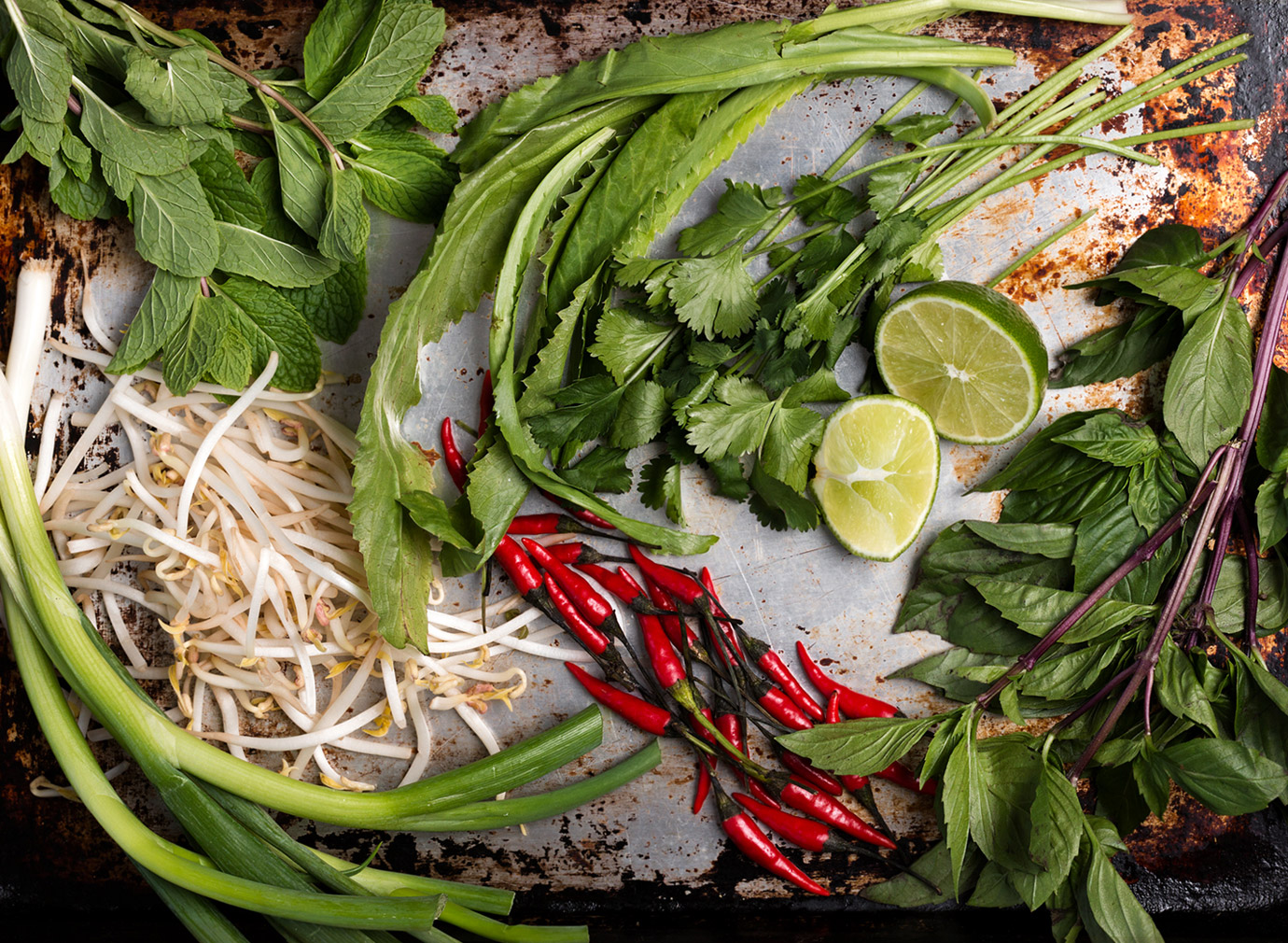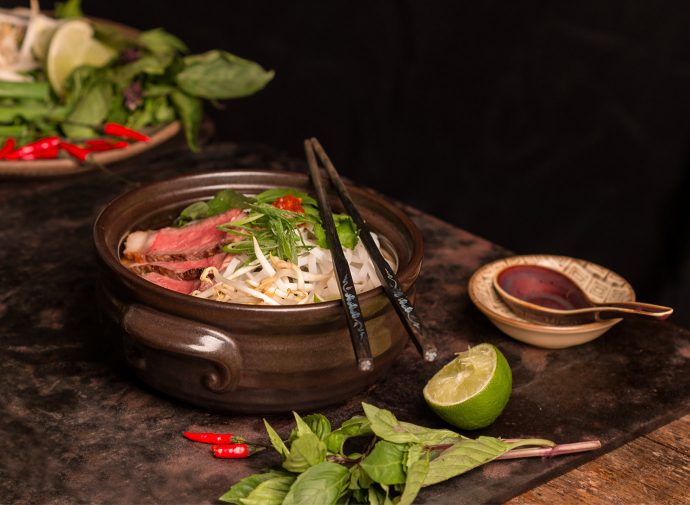Adapted from Into the Vietnamese Kitchen, Andrea Nguyen, 2011
This recipe is a perfect illustration of the guiding principles in Chinese Gastronomy and how they can be translated to prepare any cuisine. The complex pho broth must have the true flavor of beef—hsien—created by par-boiling and scrubbing the bones to remove impurities, which in turn produces a sparkling clear broth. Charring the onion and ginger, along with the addition of star anise and cinnamon stick, also contribute hsaing, or the pleasure of heady fragrance. The long, slow simmering of the stock creates nung, the rich, concentrated flavor of meat and spice. Continually skimming the broth, preferably made a day ahead, creates a broth that is rich, but not greasy (yu-er-pu-ni). Mixing flavors that blend, with textures that vary, is another important aspect of Chinese gastronomy. To illustrate, the addition of rice noodles provides a soft and silky texture (nun), while a garnish of fresh vegetables and herbs provides contrast, contributing crisp and crunchy texture (tsuei).
Makes 8 large bowls
Ingredients
Broth
2 medium yellow onions (about 1 pound total)
4-inch piece ginger (about 4 ounces)
5-6 pounds beef soup bones (marrow and knuckle bones)
5 star anise (40 star points total)
6 whole cloves
3-inch cinnamon stick
1 pound piece of beef chuck, rump, brisket or cross-rib roast, cut into 2-by-4-inch pieces (weight after trimming)
1 ½ tablespoons salt
4 tablespoons fish sauce
1 ounce (1-inch chunk) yellow rock sugar or brown sugar
Bowls
1 ½-2 pounds small (1/8-inch wide) dried or fresh banh pho noodles (“rice sticks” or Thai chantaboon)
½ pound raw eye of round, sirloin, London broil or tri-tip steak, sliced thinly across the grain (1/16 inch thick; freeze for 15 minutes to make it easier to slice)
1 medium yellow onion, sliced paper-thin, left to soak for 30 minutes in a bowl of cold water
3 or 4 scallions, green part only, cut into thin rings
1/3 cup chopped cilantro (ngo)
Ground black pepper
Optional garnishes
arrange on a plate and places at the table
Sprigs of Asian/Thai basil (hung que) and spearmint (hung lui)
Leaves of thorny cilantro (ngo gai)
Bean sprouts (about 1/2 pound)
Red hot chiles (such as Thai bird or dragon), thinly sliced
Lime wedges
Instructions
Prepare the pho broth
Char onion and ginger. Use the open flame on a grill or gas stove. Place onions and ginger on the cooking grate and let the skin char, rotating the aromatics as they cook. After about 15 minutes, they will soften and become sweetly fragrant. You do not have to blacken the entire surface, just enough to slightly cook and lend a smoky flavor to the onion and ginger.
Let cool. Under warm water, remove the charred onion skin; trim and discard blackened parts of root or stem ends. If ginger skin is puckered and blistered, smash it with flat side of knife to loosen the flesh from skin. Otherwise, use a sharp paring knife to remove skin, running ginger under warm water to wash off the blackened bits. Set aside.
Parboil bones. Place bones in stockpot (minimum 12-quart capacity) and cover with cold water. Over high heat, bring to boil. Boil vigorously for 2 to 3 minutes to allow impurities to be released. Dump bones and water into sink and rinse bones with warm water. Quickly scrub stockpot to remove any residue. Return bones to pot.
Simmer broth. Add 6 quarts water; bring the pot to a boil over high heat, then lower the flame to gently simmer. Use a ladle to skim any scum that rises to surface. Add remaining broth ingredients and cook, uncovered, for 1 ½ hours. Boneless meat should be slightly chewy but not tough. When it is cooked to your liking, remove it and place in a bowl of cold water for 10 minutes; this prevents the meat from drying up and turning dark as it cools. Drain the meat and refrigerate. Allow broth to continue cooking. In total, the broth should simmer for around 3 hours.
Pour the pho broth through a fine mesh strainer. If desired, remove any bits of gelatinous tendon from the bones to add to your soup and noodle bowl. Store tendon with the cooked beef. Discard the bones, spices and spent vegetables.
Use a ladle to skim as much fat from top of the pho broth as you like. Refrigerating over night will make this task easier. Reheat before continuing. Taste and adjust the flavor of the broth with additional salt, fish sauce and yellow rock sugar. The pho broth should taste slightly over-seasoned, because the noodles and other ingredients are not salted. If you’ve gone too far, add water to dilute. Makes about 4 quarts.

Assemble pho bowls
The key is to be organized and have everything ready to go. Thinly slice the cooked meat. For best results and ease, do this when the beef is cold.
Heat the broth and ready the noodles. If you’re using dried noodles, cover them with hot tap water and soak 15-20 minutes, until softened and an opaque white. Drain in a colander. For fresh rice noodles, just untangle and briefly rinse them in a colander with cold water.
Fill a 3- or 4-quart pot with boiling water. For each bowl, use a long-handle strainer to blanch a portion of noodles to re-heat them. As soon as the noodles have collapsed and lost their stiffness (10-20 seconds), pull the strainer from water, letting it drain back into the saucepan. Empty each portion of them into large individual bowls. Noodles should occupy 1/4 to 1/3 of bowl; the latter is for noodle lovers, while the former is for those who prize the broth.
If desired, after blanching the noodles, blanch the bean sprouts for 30 seconds in the same pot. They should slightly wilt but retain some crunch. Drain and add to the garnish plate.
Place slices of cooked meat, raw meat and tendon (if using) on top of the noodles. If your cooked meat is not at room temperature, blanch the slices for few seconds in the broth. Garnish with onion, scallion and chopped cilantro. Finish with black pepper.
Bring the broth to rolling boil. Check the seasoning. Ladle broth into each bowl, distributing the hot liquid evenly so as to cook the raw beef and warm the other ingredients. Serve your pho immediately, accompanied with the garnish plate.

